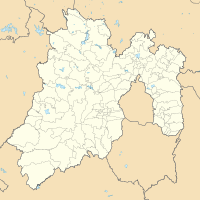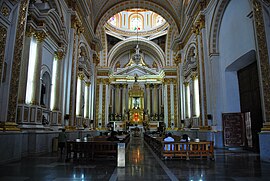Chalma (México)
| Chalma | ||
|---|---|---|
|
Coordinates: 18 ° 56 ′ N , 99 ° 26 ′ W Chalma on the map of Mexico
|
||
| Basic data | ||
| Country | Mexico | |
| State | México | |
| Municipio | Malinalco | |
| Residents | 1827 (2010) | |
| Detailed data | ||
| height | 1680 m | |
| Post Code | 52460 | |
| prefix | 714 | |
| View of the pilgrimage church from the place of the dancers | ||
| The interior of the pilgrimage church | ||
| holy spring water | ||
Chalma is an important pilgrimage site in the Municipio Malinalco , Estado de México , Mexico . The place Chalma itself, which is surrounded by imposing mountain peaks, has only about 1800 inhabitants. Every Sunday, however, and especially during Holy Week , Christmas Week and on September 29, the feast of the Archangel Michael , the number increases several times over.
history
According to tradition, in 1537 the crucified Christ appeared in a cave in which children had previously been sacrificed to the gods. As soon as this became known, a pilgrimage to the "Señor de Chalma" developed. At the end of the 16th century, Augustinian fathers were entrusted with the pastoral care of the increasing number of pilgrims; the pilgrimage church was rebuilt and expanded in 1683 and 1721.
The pilgrimage today
Every year more than two million people come here to worship the crucified Black Christ of Chalma , at the Sanctuary of Santuario del Señor de Chalma . After the Basilica de la Virgen de Guadalupe in Guadalupe , Mexico City , the Santuario del Señor de Chalma is the most visited place of pilgrimage in Mexico. During the season, the pilgrims camp for miles outside the village.
The ceremonies, like so much in Mexico, are a mixture of pre-Columbian rites and Catholic liturgy; think of the Día de Muertos, for example . The indigenous population worshiped their gods before the Spaniards arrived in the caves. One of the main gods was Oztoteotl , the god of the caves. They were often out and about for days, wreaths of flowers in their hair and incense vases in their hands.
Their god was represented in the form of a large black stone, which was said to have magical powers. Before entering the cave in which the stone was located, the pilgrims bathed in a river fed by a sacred spring and drank sacred water. Flower offerings were made, but also blood offerings.
Today the pilgrims call themselves Chalmeros . The same paths that pilgrims dance on have been used in pilgrimage for centuries. Pilgrims who take this trip for the first time wear flower crowns on their heads and are accompanied by a sponsor. Many seek the holy spring water and rub themselves off with it.
There is also a shrine in nearby Ahuehuete that attracts many. It stands at a point where a miraculous healing spring rises from the roots of an old tree . Some women pray for fertility by putting their hands in the holy spring water.
literature
- Gonzalo Obregón: El santuario de Chalma . In: Ernesto De la Torre Villar (ed.): Lecturas históricas mexicanas , Vol. 5. Universidad nacional autónoma de México (UNAM), Mexico City 1994, ISBN 968-36-3613-6 , pp. 267-278.
- Ramiro Alfonso Gómez Arzapalo Dorantes: Imágenes de santos en los pueblos de la región de Chalma. Mudos predicadores de otra historia . Escuela Nacional de Antropología e Historia (ENAH), Mexico City 2007.
Footnotes
- ↑ Gonzalo Obregón: El santuario de Chalma . In: Ernesto De la Torre Villar (ed.): Lecturas históricas mexicanas , Vol. 5. UNAM, Mexico City 1994, IS. 267–278, here p. 268.



